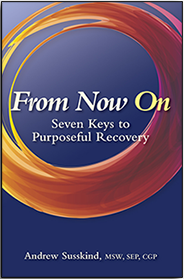Sometimes you’ll hear an old-timer at a twelve-step meeting tell a newcomer, “Do what’s in front of you and let go of the results.” This age-old advice is about taking things one moment at a time when life feels overwhelming. It removes future expectations, to focus on the here and now.
What’s so great about living in the present? It’s where your life force is most accessible—an oasis of emotional sobriety is available there. In fact, resiliency and buoyancy only exist in the here and now. But it takes mental muscle for you to breathe into each moment, and until now that muscle has been only infrequently used. Later on, we’ll take a deeper look at ways you can stretch this mindfulness muscle to achieve less self-judgment and more self-acceptance.
In twelve-step rooms you also hear a lot about faith and hope. This may feel foreign to you, but without optimism, recovery is a constant struggle. Developing a working relationship with hope requires patience. The good news is that faith will reveal itself over time if you’re patient. You’ll need to strengthen your capacity to trust and rely on other people too. Before recovery, it was scary to depend on others because of the hurt and disappointment that likely occurred in your past. It takes practice to ask for help from people, but eventually it becomes a habit that results in less anxiety and loneliness. By learning to take risks and rely on a sponsor, coach, or therapist, for example, you carve out new neural pathways in your brain that let you know trust and intimacy is not only possible, but preferable to acting out.
Hope, faith, and trust are vital elements for you to experience more meaningful connection. The term “sex addiction” entered the clinical community less than four decades ago, and we’re still learning how it works and how to heal from it. Yes, we’ve come a long way, but I believe that for as much as we do know, a lot remains unclear. One of my primary motivations for writing this book was to share an unexplored perspective with you: mainly, that the challenges of long-term recovery from sexual compulsivity offer great opportunities to learn about yourself through the integration of sex, love, and intimacy.
Action Steps:
1. Hope requires practice. Write a list of memories and experiences during which you felt hopeful. Now take stock and write down anything in your life that gives you hope.
2. Developing deeper connections to those you trust is a requirement of recovery. Emotionally reliable relationships are essential, as they move you away from isolation and your former way of life. Name the dependable people that existed in your past. Now, name reliable people in your life today. If you have difficulty identifying any, name the people who you would like to count on more.
3. Emotional sobriety requires you to live in the here and now, which brings freedom from worry for the future and anxiety about the past. Answer the question in the Emotional Sobriety section of this chapter and list a few realistic action steps to support your emotional sobriety.
4. Eliminating self-protective, medicating behaviors won’t kill you. And embracing vulnerability may be hard at first, but you’ll learn ways to connect more deeply with others. What tools do you have in your intimacy toolbox right now? What tools would you like to add?
5. It’s not the dysregulation that matters—it’s how you choose to manage it. In recovery you’re an imperfect, lovable human being. Track your dysregulated states against your more regulated states of resiliency and well-being. Keep in mind that you’re teaching your nervous system new ways to react to unpleasant, disturbing situations.
6. Change takes muscle and perseverance, and self-awareness and self-understanding create the possibility for external change. If you’re navigating a ship on the high seas and you turn the wheel slightly, you’ll end up at a completely different destination from where you planned. What is one small change you can make today that will make the biggest difference?




